Japan: The Rakan, Enlightened Disciples and Buddhist Spiritual Figures
- Olivier

- Sep 30, 2023
- 16 min read
Updated: Nov 5
The Rakan are iconic figures of Buddhism found in many temples across Japan. These characters represent the disciples of Buddha Siddhartha Gautama and are considered symbols of enlightenment. Beyond their historical significance, their unique expressions make them perfect photographic subjects. A closer look at these sometimes humorous statues.
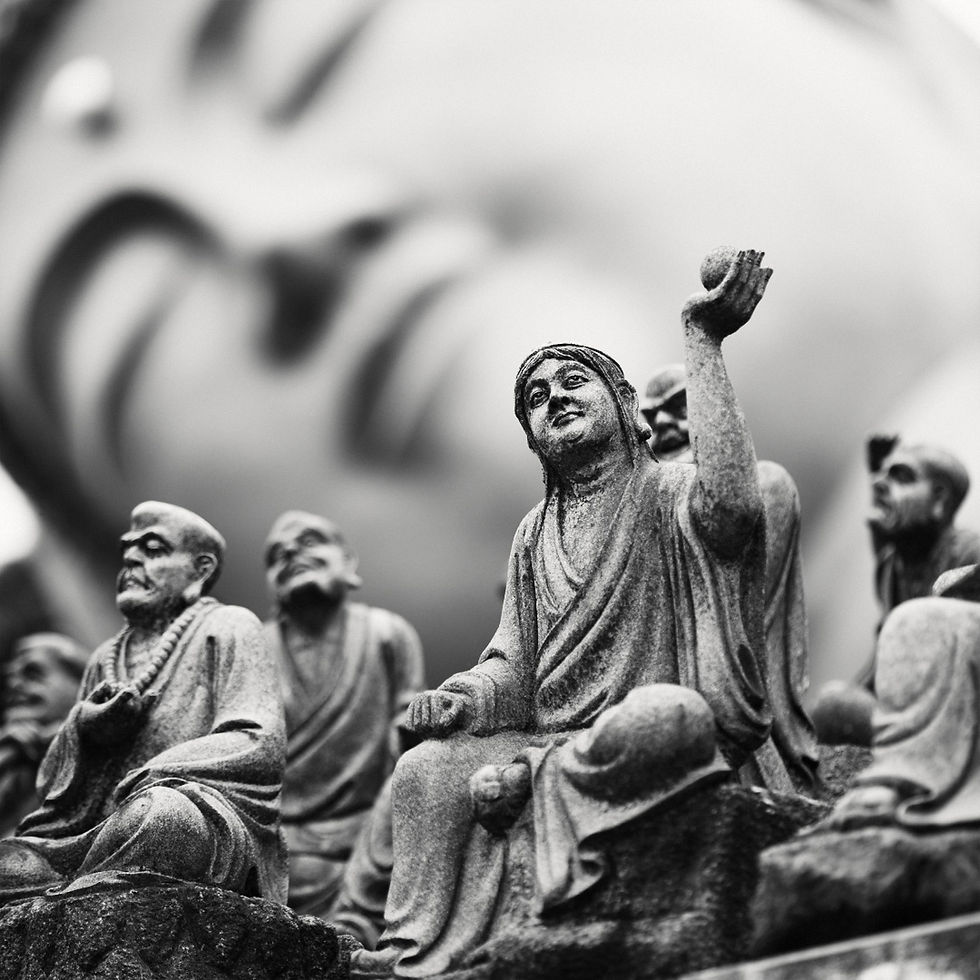
Unpenji Temple - Fine Art Print © O. Robert (Purchase here)
The Rakan hold a unique place in Japan's religious and cultural landscape. Their history is deeply connected to the evolution of Buddhism in the country. They illustrate not only the transmission of religious ideas from India and China to Japan but also how these concepts were adapted to the country's cultural context.
Today, these figures continue to inspire generations of devotees and artists, representing a living link between the past and the present, between the Asian continent and the Japanese archipelago.
Introduction
The Rakan have always held a special place in my work on Buddhist statuary over many years. Their diversity, imposing presence, and sometimes humorous expressions make them ideal subjects for photography and portraiture.
My interest in these statues likely began during my first encounters along the Henro pilgrimage paths around the island of Shikoku (read my articles on this topic). Since then, I have sought out temples known for their significant collections of Rakan. However, Unpenji Temple (No. 66 on the Henro pilgrimage) remains perhaps the most spectacular for the size and staging of its Rakan in a unique forest setting (see below).
Through this article, I wish to share my interest in these unique and photogenic sculptures by exploring the origins and evolution of their symbolism over time. You will also find a few examples of temples with notable collections that I recommend visiting if these intriguing figures catch your attention. Let’s dive in!
Contents:
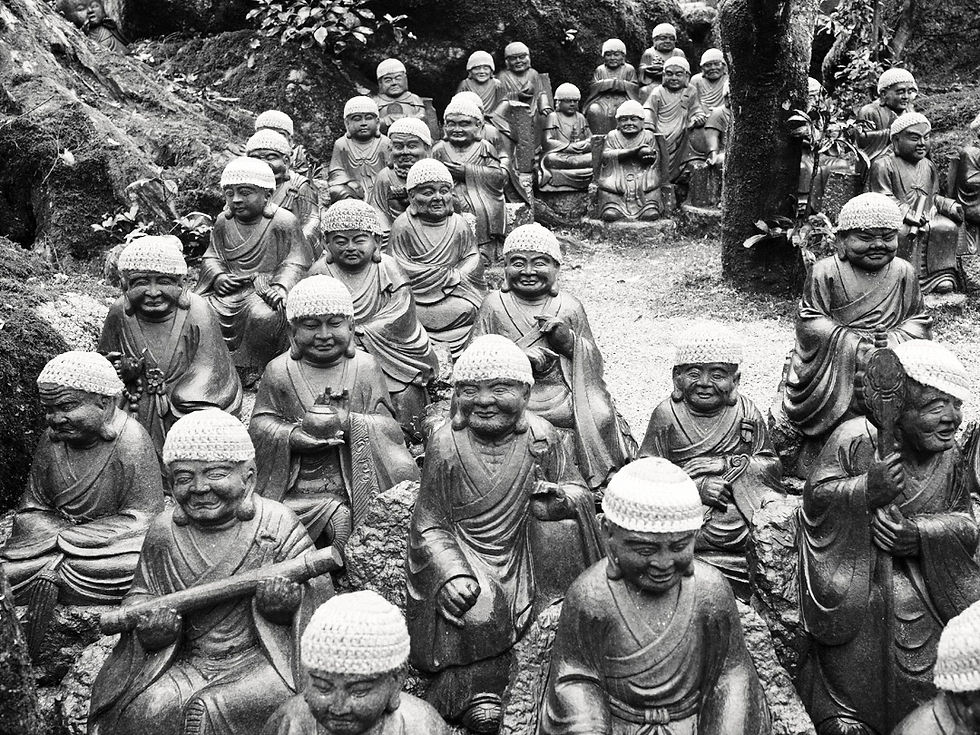
Daisho-in Temple © O. Robert
Origin and Significance of the Rakan
The Rakan, known in Chinese as Luohan (羅漢) and Arhat in Sanskrit, are major figures in Mahayana Buddhism, highly revered for their wisdom and ability to guide human beings on the path to enlightenment. The Sanskrit term "Arhat" literally means "worthy" or "venerable," and in the Buddhist context, it refers to an individual who has attained enlightenment and escaped the cycle of rebirth (samsara).
The introduction of the Rakan to Japan is directly tied to the arrival of Buddhism in the 6th century. The earliest representations of these figures were heavily influenced by Chinese models, which in turn were derived from Indian traditions. The traditional number of Rakan present in temples varies depending on the historical period and the specific temple (as discussed below). Each Rakan has a unique expression and posture, symbolizing the universality and diversity of Buddhist wisdom.
Rakan also hold a place in Japanese funerary and commemorative practices. For example, in some temples, it is possible to commission personalized Rakan statues to honor the deceased, with the hope that these Arhats will guide souls toward enlightenment.
History and Development
The Rakan, or Arhat, have played a significant role in Japanese Buddhism over the centuries. Their importance and representation have evolved in response to the religious, political, and cultural dynamics of each historical period. Below is an overview of their place and significance across the major periods of Japanese history.
Asuka Period (538-710) and Nara Period (710-794)
The introduction of Buddhism to Japan during the Asuka period marked the beginning of the representation of the Rakan. Imported from China and Korea, Buddhism was quickly adopted by the imperial court, notably with the construction of grand temples like Hōryūji (法隆寺) in 607.
During this period, the Rakan were not yet ubiquitous but began to appear as important spiritual figures. They were primarily depicted as models of wisdom and discipline, embodying the Buddhist ideals that the court and aristocracy sought to promote to reinforce the moral authority of the state.
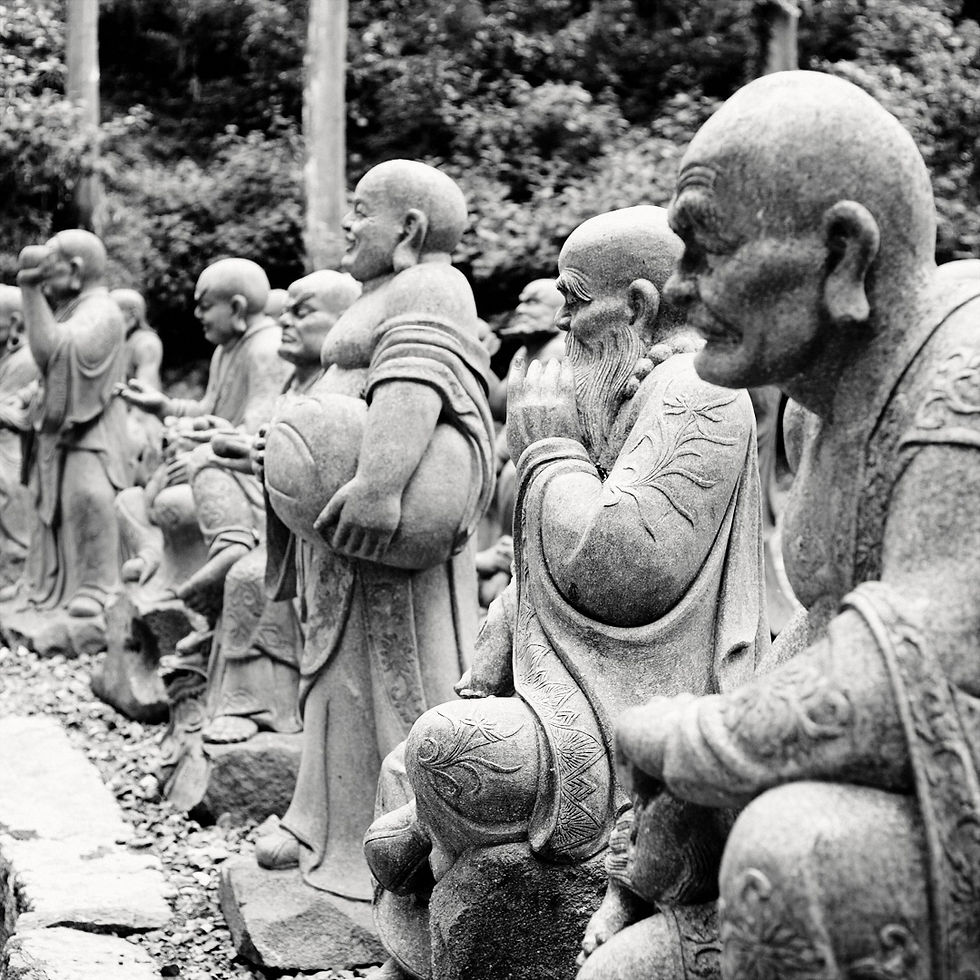
Unpenji Temple - Fine Art Print © O. Robert (Purchase here)
Heian Period (794-1185)
During the Heian period, Buddhism spread more widely beyond the aristocracy to the general population. This era also saw the rise of the Tendai and Shingon Buddhist schools, which became predominant. The Rakan began to be more venerated, especially in temples associated with these schools, where they were sometimes depicted in mandalas and other sacred artworks.
Their role as protectors of Buddhist law (Dharma) and as intercessors with deities on behalf of the faithful became more pronounced. However, their worship remained somewhat secondary compared to that of major Buddhist deities like Kannon (観音) or Amida (阿弥陀).
Kamakura Period (1185-1333)
The Kamakura period was a time of political upheaval and religious transformation, marked by the emergence of Zen Buddhism and Pure Land Buddhism, which gained popularity among the samurai and common people. The Rakan took on a central role in Zen Buddhism, where they were revered not only as models of monastic discipline but also as figures who had attained enlightenment, embodying the ideals of simplicity and rigor championed by this school.
Kenchōji (建長寺) and Engakuji (円覚寺), two major Zen temples in Kamakura, are examples where the Rakan are particularly revered. The statues of Rakan from this period become more expressive, often sculpted with distinctive facial features to illustrate their accumulated experience and wisdom. These representations also serve as reminders to Zen practitioners of the challenges and efforts required to achieve enlightenment.
Muromachi Period (1336-1573)
During the Muromachi period, Zen Buddhism continued to flourish, along with the veneration of the Rakan. This era also witnessed the zenith of Buddhist art, with more elaborate representations of the Rakan in paintings, sculptures, and dry landscape gardens known as "Karesansui." The Rakan became symbols of spiritual mastery and the transcendence of earthly desires.
Tōfukuji (東福寺) and Tenryūji (天龍寺), two Zen temples in Kyoto, incorporated representations of Rakan with facial expressions specific to the Zen tradition. The presence of these figures in the temples serves as a reminder to practitioners of the importance of meditation and personal discipline in the pursuit of enlightenment.
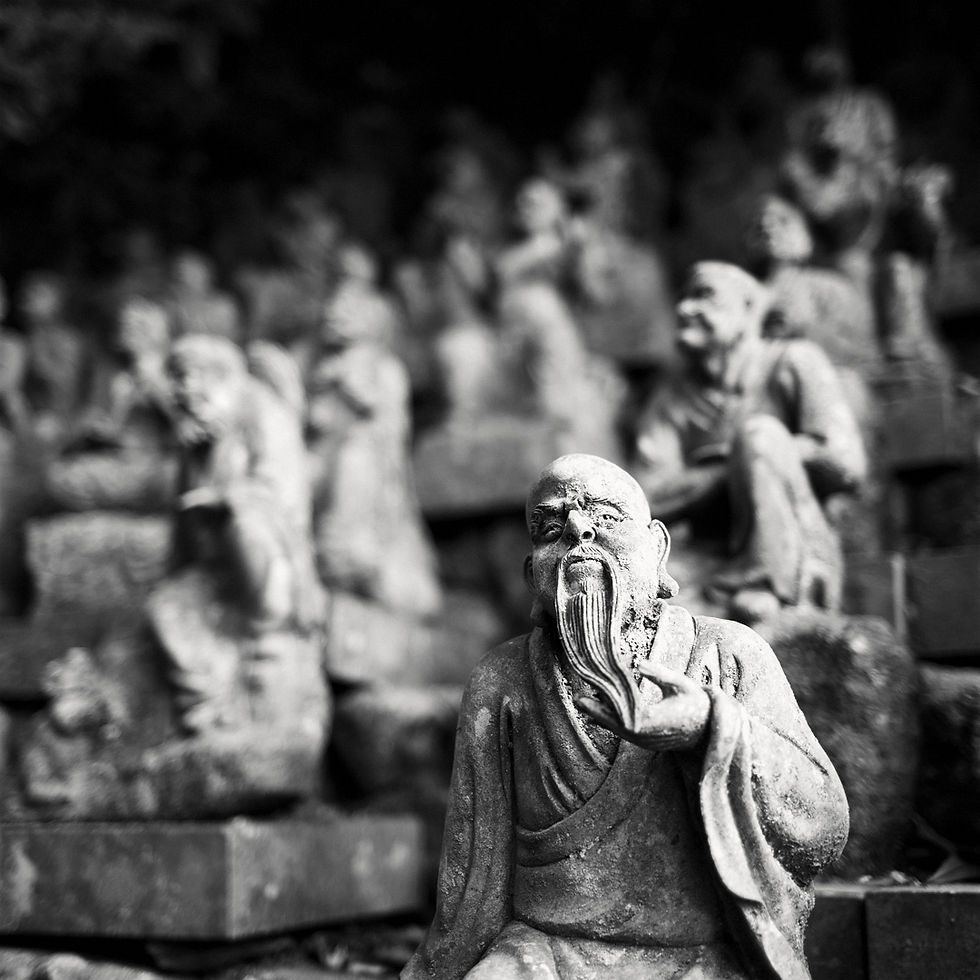
Nanzo-in Temple - Fine Art Print © O. Robert (Purchase here)
Edo Period (1603-1868)
The Edo period saw a renewed interest in the Rakan, particularly with the rise of the "Gohyaku Rakan" (五百羅漢) movement, or the Five Hundred Rakan. This movement was marked by the construction of temples specifically dedicated to the Rakan, housing, as the name suggests, 500 statues representing these sacred figures. The Rakan became protectors of the community, and their worship became widely popular across all social classes.
The 500 Rakan at Gohyaku Rakanji Temple (五百羅漢寺) in Tokyo are an emblematic example of this movement. This temple attracts numerous pilgrims who come to pray for protection, healing, and prosperity. Each Rakan statue, with its unique posture and distinct expression, reflects the diversity of paths to enlightenment, making these figures particularly relatable to the people.
Meiji Period (1868-1912)
With the Meiji Restoration, Shinto became the state religion, and Buddhism, including the veneration of the Rakan, experienced a temporary decline due to the policy of separation of Shinto and Buddhism known as "Shinbutsu bunri". However, Buddhist temples continued to honor the Rakan, even though their worship lost public prominence.
Contemporary Period
In the 20th century, the Rakan have often been integrated into contemporary religious practices, continuing to be revered for their wisdom and protective role. Temples with Rakan statues are still visited by devotees, and representations of the Rakan remain a source of inspiration for artists and Buddhist practitioners.

Temple Sennyoji - Fine Art Print © O. Robert (Purchase here)
Postures and Facial Expressions of the Rakan
The positions, postures, and facial expressions of the Rakan are rich in symbolism. They reflect various aspects of their wisdom, personality, and spiritual experience. Each statue is designed to embody a particular facet of enlightenment, compassion, or the challenges encountered on the spiritual path leading to it.
What their positions and faces represent
Postures of the Rakan
1. Meditation Posture: Many Rakan are depicted in a meditation posture, sitting in the lotus position with their hands placed one on top of the other, palms facing upwards. This posture, known as "Dhyana Mudra" in Sanskrit, symbolizes concentration, mental tranquility, and the attainment of enlightenment through deep meditation.
2. Relaxed Posture: Some Rakan are depicted in relaxed postures, sometimes even reclining or with one foot resting on a leg. These postures symbolize spiritual freedom and the ease they have attained after overcoming worldly attachments. They can also reflect their humanity, making them more accessible and relatable to the faithful.
3. Teaching Posture: Rakan may be shown with one hand raised in a gesture of blessing or teaching (Varada Mudra). These postures symbolize their role as spiritual guides, offering wisdom and protection to those who seek to follow the path of the Buddha.
4. Gesture Posture: Some statues depict the Rakan performing specific mudras (symbolic hand gestures) that may represent the intention to dispel fear, grant blessings, or signify refuge in the Buddha. For example, the right hand raised with the palm facing outward is a gesture of protection and calming fears (Abhaya Mudra).
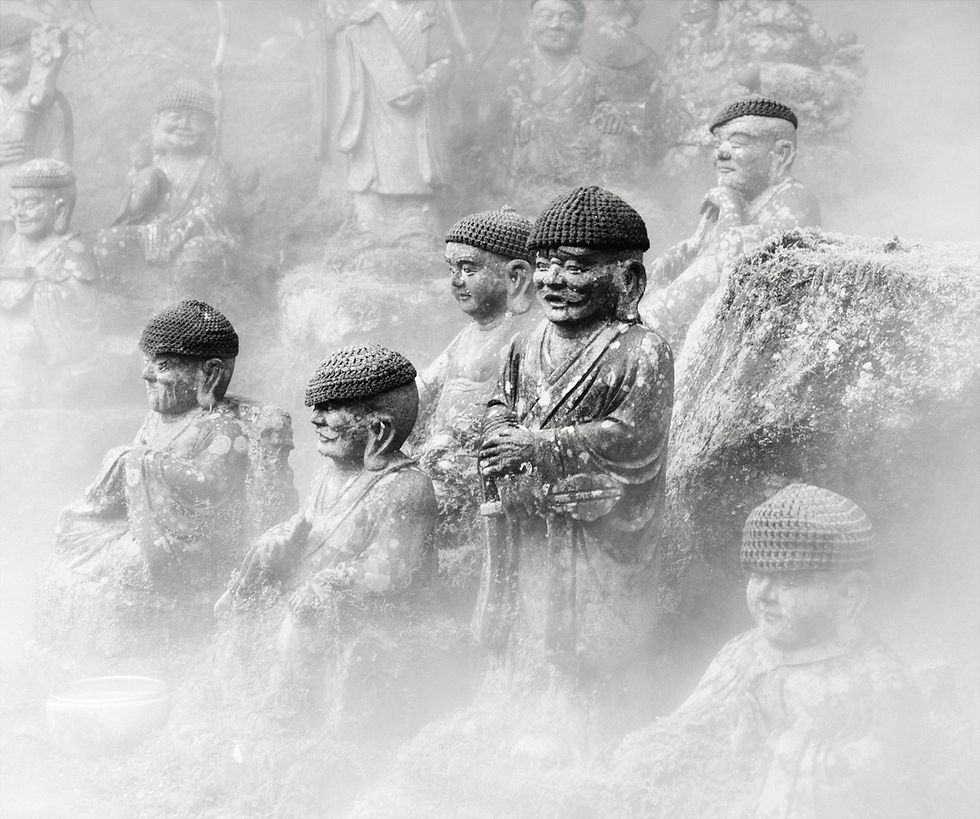
Daisho-in Temple © O. Robert
Facial Expressions of the Rakan
1. Serene Expression: Many Rakan have serene and peaceful facial expressions, symbolizing their detachment from the material world and their spiritual attainment. These calm faces represent the state of enlightenment, characterized by tranquility and inner peace.
2. Smiling Expression: Smiling or laughing Rakan reflect the spiritual joy they have achieved. Their smiles can also be interpreted as a form of benevolence towards human beings, highlighting their compassion and desire to share Buddhist wisdom.
3. Austere Expression: Some Rakan are depicted with stern or concentrated faces, expressing the discipline and austerity they practiced to achieve enlightenment. These expressions serve as reminders to practitioners that enlightenment requires sustained effort, constant vigilance, and self-mastery.
4. Exaggerated Expression: In some temples, Rakan are depicted with distorted faces and exaggerated features, often to highlight their unique character or to show that they have overcome extreme challenges. These expressions can also symbolize the diversity of human and spiritual experiences, suggesting that enlightenment can take various forms.
5. Wrinkled Face: Elderly Rakan, with deep wrinkles, represent the wisdom gained through age and experience. Their appearance also emphasizes the passage of time and renunciation of earthly pleasures in favor of a life dedicated to the pursuit of spiritual truth.
The positions and expressions of the Rakan vary from one temple to another, depending on regional influences, historical periods, and dominant Buddhist traditions. For example, in Zen temples, Rakan are depicted in a more austere and simple manner, while in other Buddhist traditions, such as Shingon, they are often more ornate and expressive.
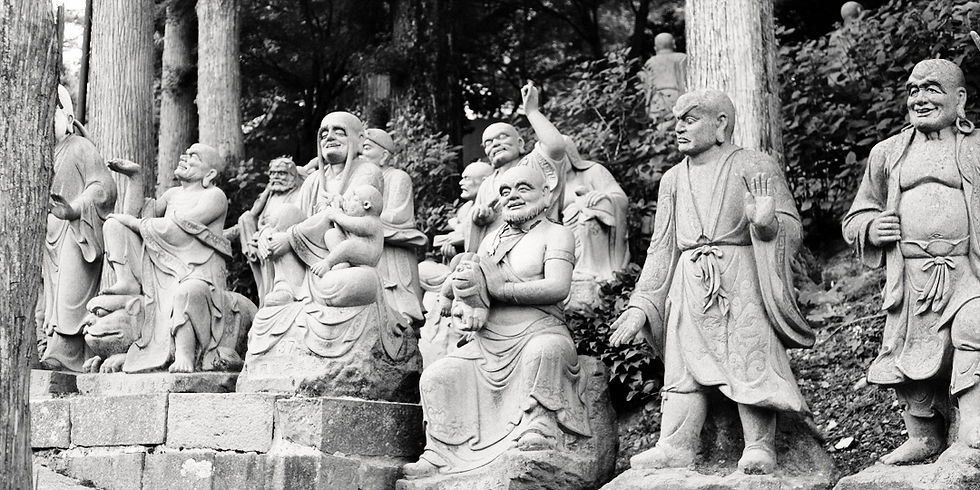
Unpenji Temple © O. Robert
The positions and faces of the Rakan are not merely artistic expressions but also profound manifestations of Buddhist teachings. By visiting a temple and observing these statues, both devotees and visitors are encouraged to reflect on their own spiritual path and find inspiration and solace in the diverse forms that enlightenment can take.
Number of Rakan in Temples
The number of Rakan present in Japanese temples can vary considerably depending on the tradition and design of the temple. Here is some information on the typical number of Rakan found in certain temples:
1. 16 or 18 Rakan: This number is traditional in many Buddhist temples, especially those influenced by early Indian and Chinese traditions. These Rakan are often depicted as the principal disciples of the Buddha who have attained enlightenment. Some older temples or those adhering to strict traditions limit their representations to these 16 or 18 figures.
2. 15 or 53 Rakan: Some temples feature smaller or larger groups of Rakan, depending on the tradition or the patron who funded the statues. These sets are often linked to local beliefs or specific narratives.
3. 500 Rakan: As mentioned earlier, many temples in Japan, particularly during the Edo period, adopted the tradition of the 500 Rakan. This number is symbolic and represents the multitude of saints who have achieved enlightenment, each with a unique appearance and expression. It is also commonly accepted that the number of Rakan does not exceed 500.
In addition to Gohyaku Rakanji in Tokyo, a representative example is Unpenji Temple, which I mentioned in the introduction. Another example is the beautiful Nanzo-in Temple located in Sasaguri on Shikoku Island. Finally, Sennyoji Temple in Itoshima features 500 statues displayed on the slope of a tree-covered hill, regularly shrouded in mist. An exceptional sight to behold.
To learn more about the Shingon tradition, which forms the basis of my work on Buddhist statuary, you can read my articles here.
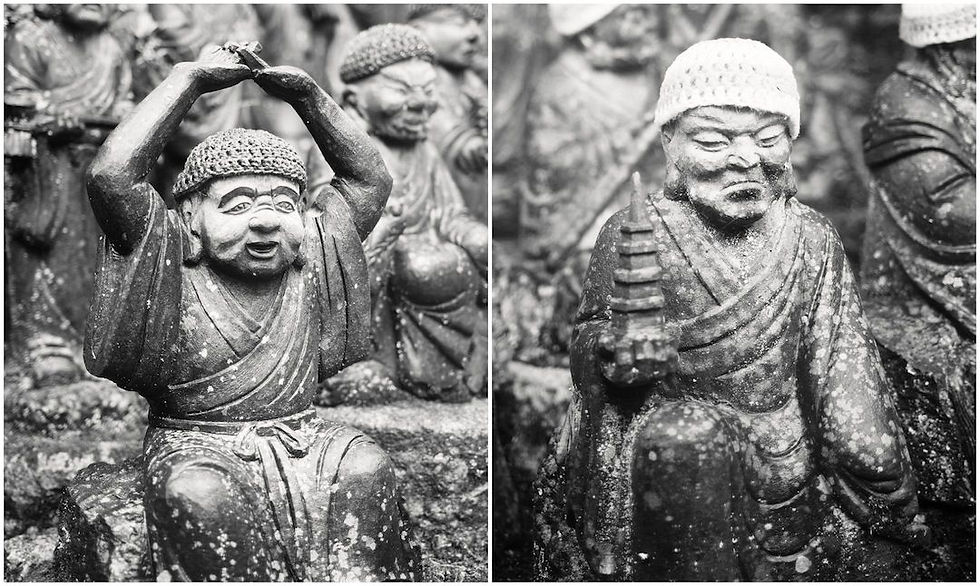
Daisho-in Temple © O. Robert
Significant Temples for Their Rakan Collections
Unpenji, Nanzo-in, and Sennyoji are my top three temples for their Rakan collections, as well as for their historical significance. All three are part of the Shingon tradition. I highly recommend them to anyone interested in exploring this unique aspect of Buddhism. Here is some information about them, along with other major temples renowned for their Rakan collections.
Unpenji (雲辺寺) in Kanonji
Unpenji is one of the most famous temples in Shikoku, known particularly for its impressive collection of Rakan. It is located in Kanonji City (観音寺市) in Tokushima Prefecture. Situated on Mount Unpen at an altitude of 911 meters, it is the highest temple on Shikoku Island.
Unpenji was founded in the 8th century by the monk Gyōki (行基), a revered figure in Japanese Buddhism. The site is renowned for its mystical atmosphere, attributed to its mountainous location often shrouded in mist, which imparts an aura of spirituality and tranquility. It is one of the 88 temples on the Henro pilgrimage, being the 66th temple on this sacred route.
Nanzo-in (南蔵院) in Sasaguri
Nanzo-in, located in Sasaguri in Fukuoka Prefecture, is primarily known for housing one of the largest reclining Buddha statues in the world (featured photo of this article). This remarkable temple is an important location in our Photo Tours in Japan. Discover the programme here and join us for a unique adventure beyond the lens.
Nanzo-in has a relatively recent history compared to other Shingon temples, having been founded in the 19th century. The temple gained international fame due to its bronze Buddha statue, which measures 41 meters in length and weighs approximately 300 tons, constructed in 1995. Nanzo-in is part of the Sasaguri pilgrimage, which also includes 88 temples, serving as a miniature version of the famous Shikoku pilgrimage. Read my article about Nanzo-in Temple here.
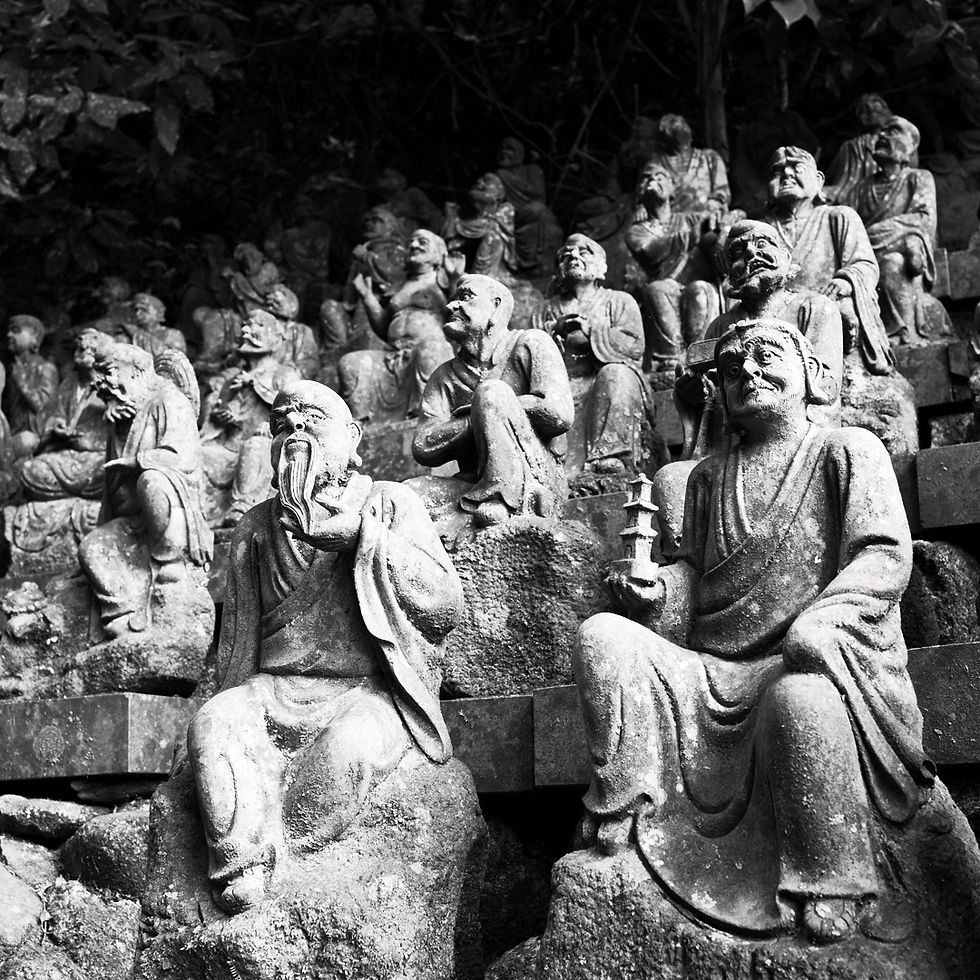
Nanzo-in Temple - Fine Art Print © O. Robert (Purchase here)
Nanzo-in features an impressive group of 500 Rakan. These statues are scattered throughout the temple complex, particularly along the paths that wind through the mountain and alongside the majestic reclining Buddha statue.
Sennyoji (千如寺) in Itoshima
Located in Itoshima, Fukuoka Prefecture, Sennyoji was founded in the early 9th century during the Heian period. It is also renowned for its collection of Rakan and its beautiful natural landscapes. The temple is surrounded by lush forests and gardens, providing a serene setting for spiritual contemplation. Sennyoji is famous for its century-old maple trees, which attract many visitors during the autumn season.
The temple houses a collection of 500 Rakan, dispersed throughout the complex. Its geographic location allows these statues to be placed at the base of majestic cedar trees. This forest stretches across a hill frequently shrouded in mist, creating a living tableau conducive to meditation. The statues vary in terms of expressions and postures, with some being serene and meditative, while others are more dynamic or in teaching postures.
Todaiji (東大寺) in Nara
Founded in 752, Tōdaiji is one of the most iconic temples in Japan and houses the country's largest bronze Buddha statue, Daibutsu. Although it is best known for this major work, Tōdaiji also features representations of Rakan, symbolizing their crucial role in the transmission of Buddhist teachings. The temple itself, with its long history and connections to the imperial court, has played a vital role in the propagation of Buddhism in Japan.
Todaiji is an important location in our Photo Tours in Japan. Discover the programme here and join us for a unique adventure beyond the lens.
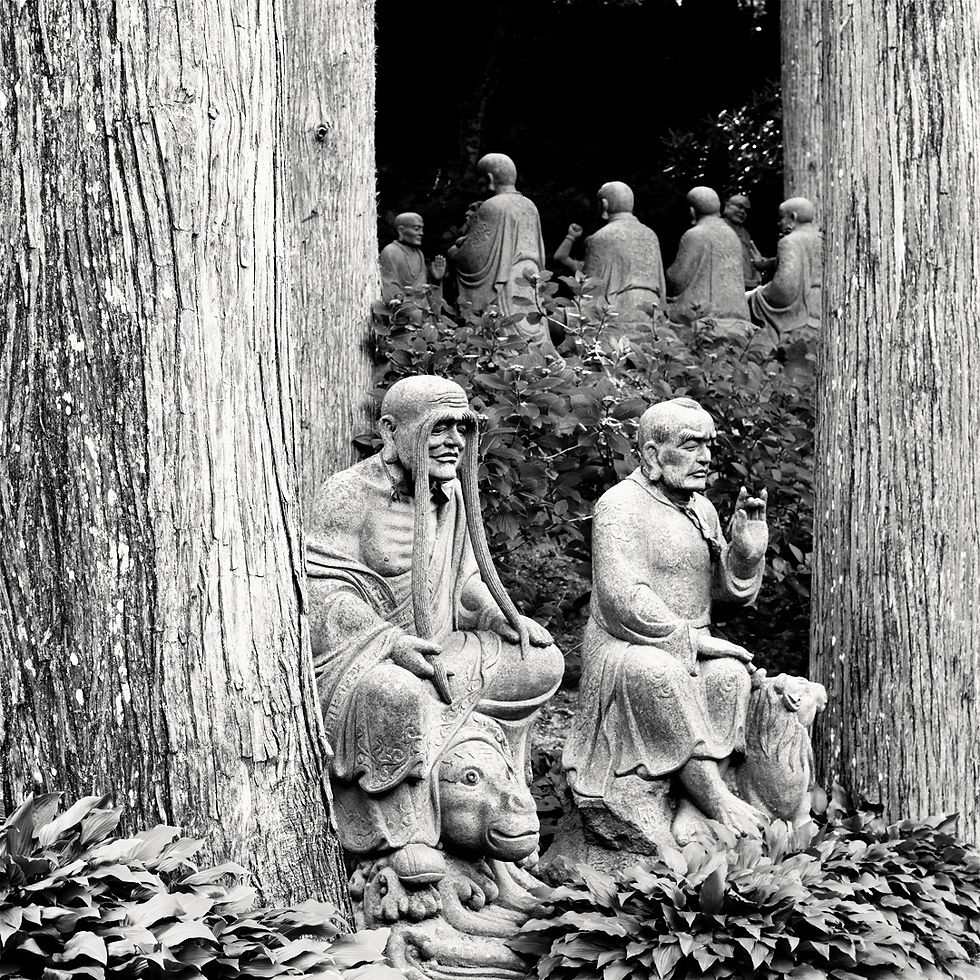
Unpenji Temple - Fine Art Print © O. Robert (Purchase here)
Yakuō-in (薬王院) in Tokyo
Located on Mount Takao, Yakuō-in is a temple founded in 744 by Emperor Shōmu. This temple is a notable example where the Rakan are depicted not only for their wisdom but also for their role as protectors of travelers and pilgrims.
The temple houses a complete set of 500 Rakan, each with a unique expression, illustrating the diversity of spiritual achievements.
Daishō-in (大聖院) on Itsukushima
Situated on the island of Itsukushima, also known as Miyajima, in Hiroshima Prefecture, Daishō-in was founded in 806 by Kūkai (空海), also known as Kōbō-Daishi, the founder of the Shingon school (read my articles on the subject). Daishō-in has been visited by emperors and nobles over the centuries, which has enhanced its historical significance and earned it a place on the UNESCO World Heritage List.
Its impressive collection of 500 Rakan is arranged along a path winding at the entrance of the temple. The Rakan Path at Daishō-in is particularly favored by photographers and pilgrims for its ability to evoke a sense of serenity and devotion. The statues, often small and discreet, are adorned with hats knitted by devotees. Read my article about Daishō-in Temple here.
This remarkable temple is also an important location in our Photo Tours in Japan. Discover the programme here and join us for a unique adventure beyond the lens.
Shōfukuji (聖福寺) in Fukuoka
Founded in 1195 by the monk Eisai, Shōfukuji is recognized as the first Zen temple built in Japan. This temple is home to a notable series of Rakan statues, reflecting the significance of the Arhats in Zen tradition.
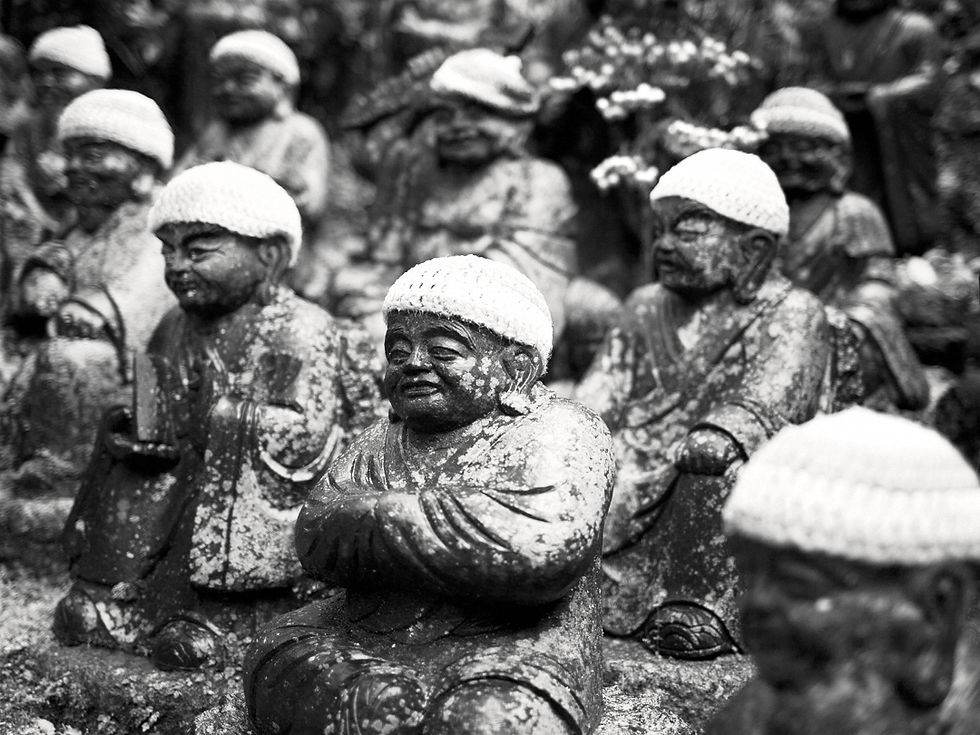
Daisho-in Temple © O. Robert
Though often more recent, these statues are part of a tradition that dates back to the temple's founding, marking the ongoing influence of the Rakan in Zen Buddhism. Shōfukuji typically features groups of 16 or 18 Rakan. Unfortunately, it is no longer possible to view this collection of Rakan without special permission.
Gohyaku Rakanji (五百羅漢寺) in Tokyo
Originally built in 1695 and reconstructed several times, Gohyaku Rakanji is famous for its 500 Rakan statues, which gives the temple its name. The temple has been relocated multiple times, notably due to fires and destruction during World War II.
Although the statues have been damaged over time, they remain a major attraction and reflect the devotion of the faithful to these spiritual figures. Each statue is unique, showcasing facial expressions and postures typical of Edo-period Buddhist art.
The Rakan and Photography
The Rakan, with their embodiment of wisdom and serenity, represent a profound spiritual richness that is beautifully suited to the art of black and white photography. Each statue, through its unique expression and posture, is a silent testament to the compassion and spiritual journey leading to enlightenment according to Buddhist beliefs. Capturing these figures in black and white transcends the materiality of their forms, revealing the timeless essence of their presence.
Black and white photography enhances the texture of the Rakan, highlighting the interplay of shadows and light that shape their faces, marked by wisdom and spiritual trials. Without the distraction of color, the viewer's attention is drawn to subtle details such as the wrinkles on their faces, the folds of their garments, or the intensity of their gaze. These details not only reveal the individuality of each Rakan but also underscore the universality of their spiritual message.
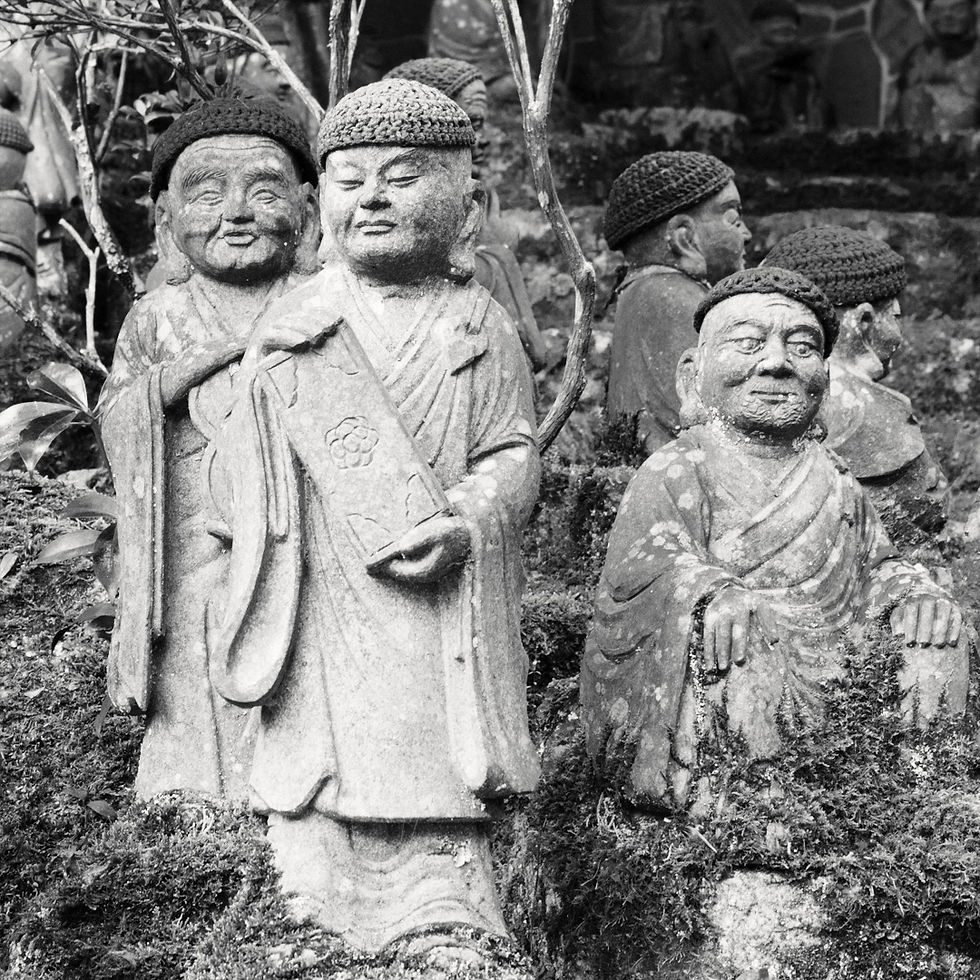
Daisho-in Temple © O. Robert
Photographing the Rakan involves a deep respect for what they represent. The images captured are not merely reproductions of artworks; they are windows into the invisible, moments of meditation frozen in time. Black and white becomes a means to explore the spirituality of these venerable sculptures, allowing for an intimate encounter between the artist and the sacred. Each photograph thus reflects a visual meditation, a tribute to the wisdom embodied in these millennia-old figures.
Congratulations! You have reached the end of this article. I am pleased to offer you your first WISE VISA CARD. Exclusively here:




















